



Having cruised down to Aswan we were now heading back North, to Luxor, the Nile helping us move with its current, taking us past the sights of daily life along the banks, it’s a peaceful, serene, yet hot experience, but thoroughly enjoyable and fascinating to watch.
I don’t know how, but on previous trips I had missed the unusual square water taxis, carrying locals from east to west, strange looking vessels, it was great to see them this time, something else to add to the memory bank in the brain, ready for that pub quiz question!

Senusret I was the 2nd Pharoah in the 12th Egyptian Dynasty, who embarked on a considerable building programme over his ~40 year reign, in part he rules co-regent with his father Amenemhat I and subsequently with his son Amenemhat II as co-regent. He married his sister Neferu III, a practise commonplace in Egyptian times, as well as having more than one wife!
Karnak, the temple complex near Luxor was one such project he started, around 2055BC and comprising of multiple temples, chapels and structures, it is understood that over 30 Pharaohs were in some part involved in its construction, over a period of 2,000 years, its very big!
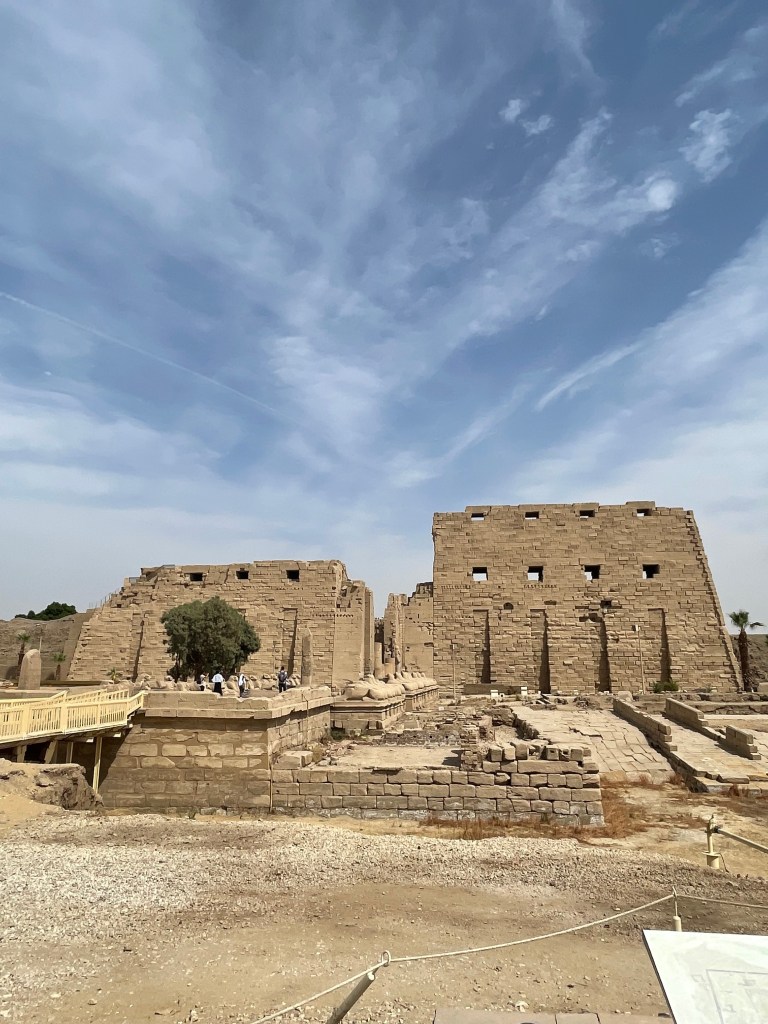


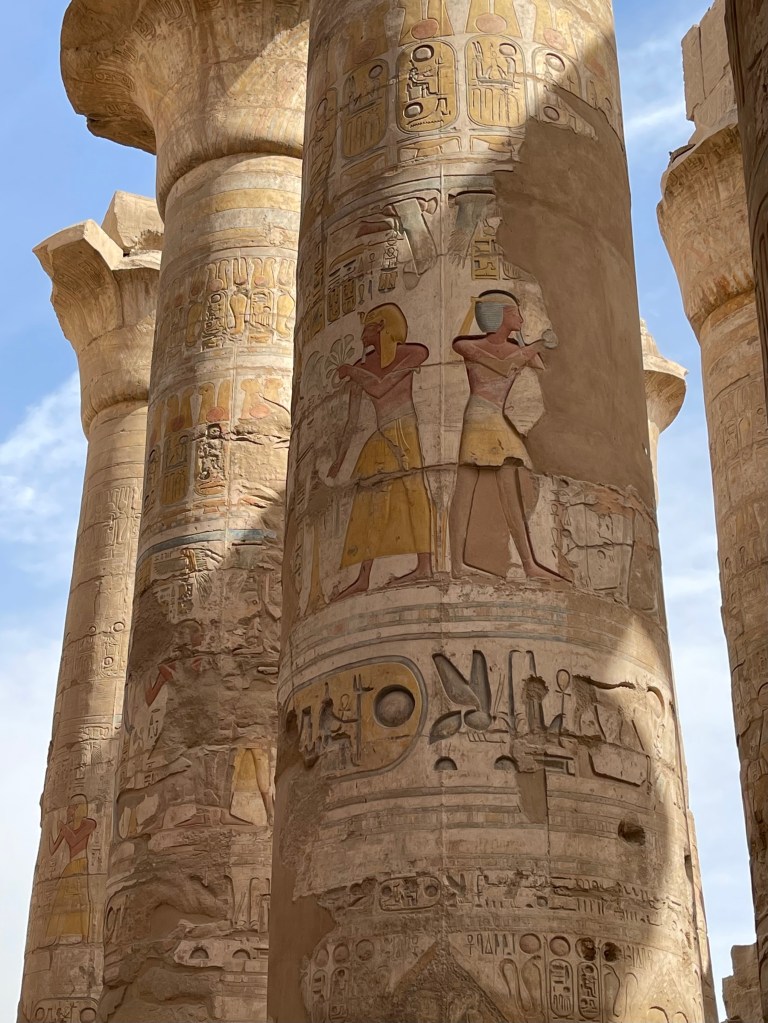
Egypt’s history and monuments always have an effect on me, they are truly mind-blowing, hiding secrets, telling stories, the skills of the workmen is just amazing, and especially so at Karnak. They have recently been testing a new restoration method on some of the pillars to remove the 1000’s of years of grime and leave the original colour behind, you can see the results above, just wow!
As you enter the main temple complex of Amun-Re there are still clues as to the methods they used to construct the massive structures, take a trip and find out how they managed to build such impressive buildings.


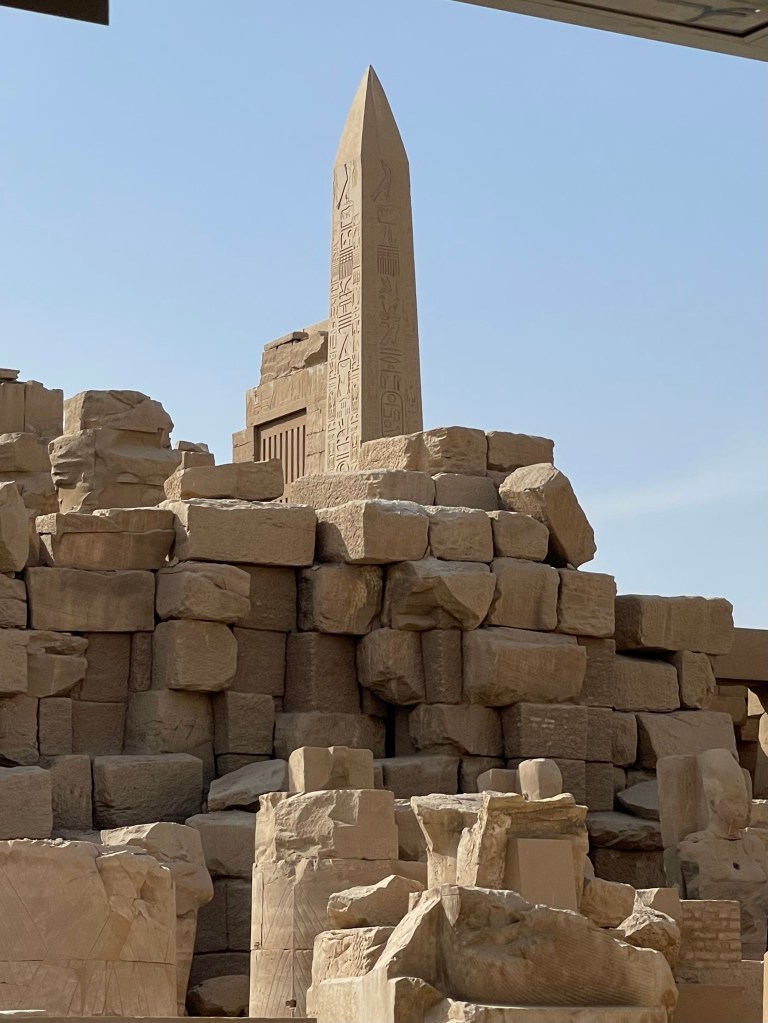
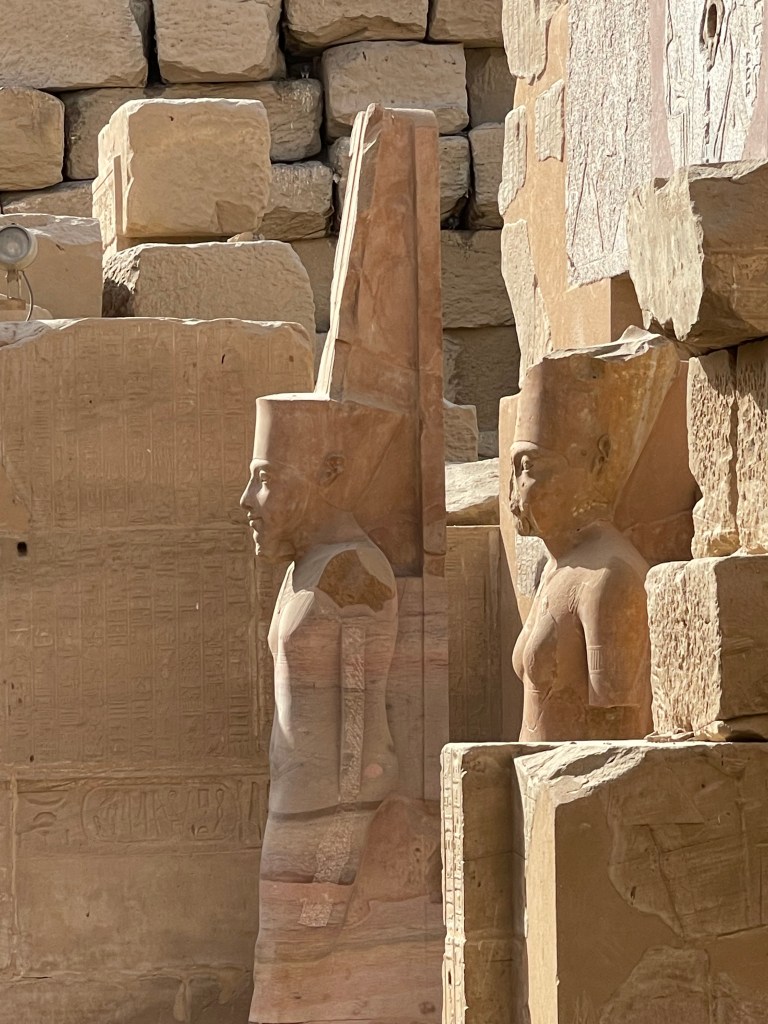
You will remember the unfinished or more apt, broken obelisk at the quarry at Aswan. Karnak originally had 29 obelisks, 17 remain the tallest being Hatshepsut’s obelisk, ~29Metres high, it’s impressive. There is another ‘unfinished’ obelisk, also dedicated to Hatshepsut and located in the northern quarry at the temple, some 42Metres long.


I’ve chosen a couple of significant and important views in the massive Karnak complex, and with my good friend Ahmad’s support, and some significant research am able to explain their meaning in more detail, please go to the hyperlinks for even more information on points of relevance. So here we go!
The Great Hypostyle Hall, a forest of 134 columns in the precinct of Amon-Re represents the primeval papyrus swamp from which Atum, a self-created deity, arose from the waters of Nun at the beginning of creation. The picture above (left) is known as column no.7, and Seti I on the right, is making an offering of Lettuce leaves to Amun, the creator god on the left.
This depiction was a common ritual, an act of devotion in ancient Egyptian religion. Its other significance, it was thought that lettuce increased fertility by allowing more sperm to be produced, the Egyptians were quite an advanced and forward thinking nation, as more recent studies have scientifically shown!
Maat, ancient concepts of truth, balance, order, harmony, law, morality and justice was also the goddess and the personification of truth, cosmic balance, and justice. Her ostrich feather represents a truth. Maat were the principles that were followed by Egyptians in their daily lives and ultimately formed the basis of law in Egypt.
Egyptian society followed these sets of rules and doctrines, performing complex daily rituals to appease the gods. How do we know? Written documents in the form of papyrus, describing the complex procedures in considerable detail. Known as Papyrus Berlin 3055 the document contains over 66 stages and is a fascinating look into daily life all those years ago.
The slab on the right was built in Hatshepsuts time in 1520BC and is part of a list of the daily offerings in numbers to be given to Amun-Ra, any leftovers being given to the people, and forms further evidence of the contents of Papyrus Berlin 3055 truly fascinating stuff.
Deep Breath…….

It’s difficult to appreciate the immense size of the ‘Hypostyle Hall’, pictures don’t do it justice, you have to visit to feel the atmosphere, and, in the heat of the sun, take a deep breath and try and imaging what is was like in ~2000BC, some 4023 years ago! A stone mason, creating part of a pillar, an artist, filling in colour, erecting an obelisk, it must have been a magical and mystical time……
We spent some time at Karnak being educated on various important aspects of the site, some free time to take in the atmosphere and then it was back on the coach, next stop the Temple at Luxor, just down the road.

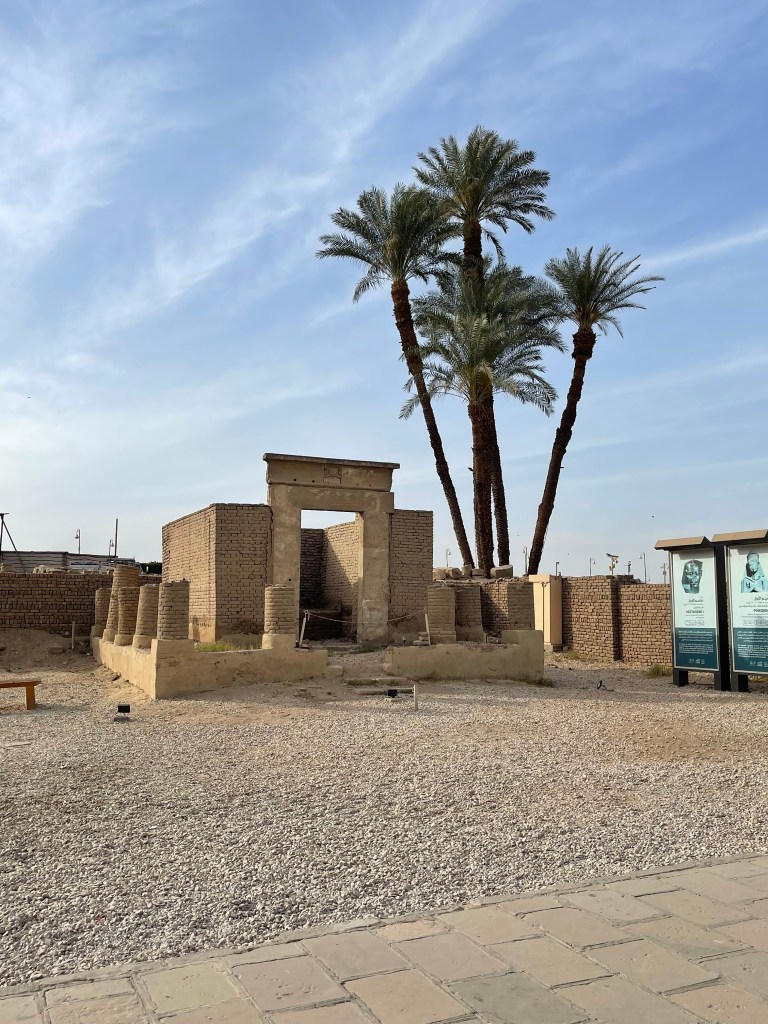


Luxor temple is connected to Karnak by a ‘road’ some 2.7km long, known as the ‘Avenue of Sphinxes’, it was lined by 100’s of Rams Head and Sphinx statues and would have been quite impressive during the Festival of Opet, which at its peak lasted 27 days!
Much of the avenue remained covered until the early 1900’s, but, following 7 decades of restoration, and, following a grand ceremony, it finally re-opened in November 2021.
At the end of the avenue on the right had side there is a small structure, a chapel, built by Hadrian and sitting in the ‘Court of Nectanebo’ called the Chapel of Serapis, pictured above left and middle. Serapis is a Graeco-Egyptian deity whose cult, was introduced during the third century BCE on the orders of Pharaoh Ptolemy I Soter of the Ptolemaic Kingdom as a means to unify the Greeks and Egyptians in his realm. It’s constructed of burnt brick and sits atop a plynth 12 metres by 8 metres and contains a single remaining statue.
There are numerous discussions as to the reason why Egyptian Pharoah statues are always presented with the left foot forward, as you can see in the picture on the right. I will leave you to explore and ponder, at Luxor temple, during its restoration a mistake was made if you look at the picture of the front of the temple above, check the statue on the left, the reconstruction accidentally put the wrong foot forward, ooops!
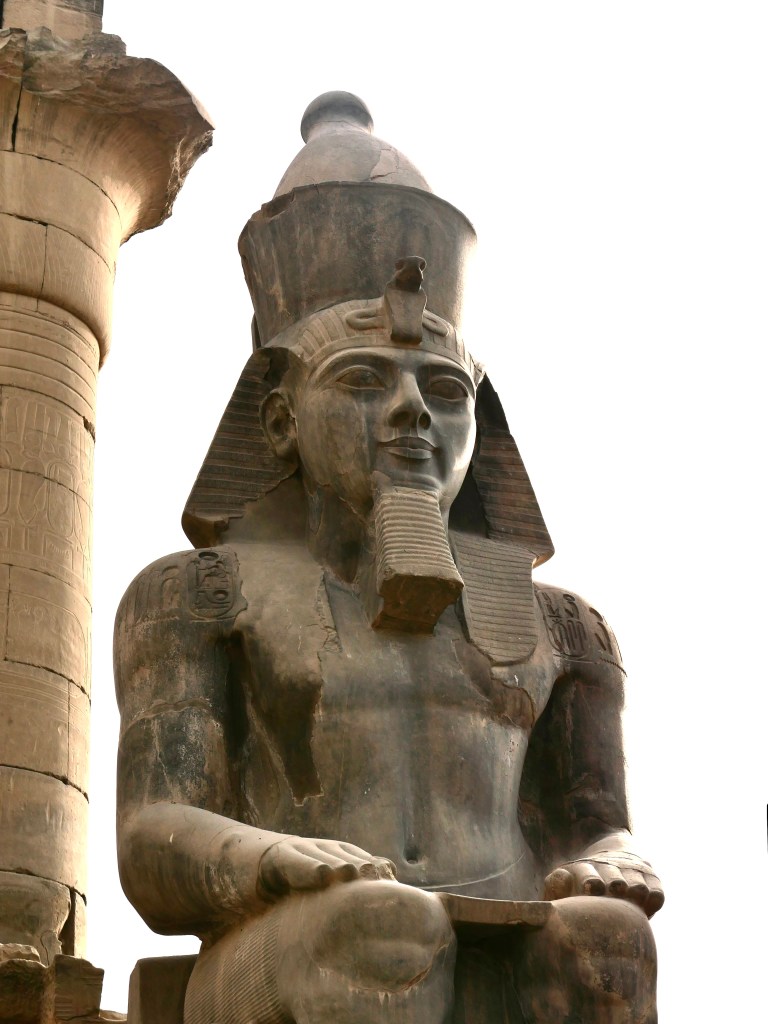


One of my favourite statutes inside part of the Temple, one of many is that of Rameses II, left above and middle. It’s in extremely good condition and portrays a powerful man, but what do we know about him, here are some interesting snippets gained from historic texts (not the phone ones :-), and hieroglyphic inscriptions in numerous temples.
- Rameses II is THE MOST FAMOUS of Pharoah’s, although Tutankhamen, and his mask of solid gold may be more in the public eye due to Howard Carter et al.
- He Lead the Egyptian Army at the Battle of Qadesh against the Hittites in Syria in ~1274 BC, the jury is still out as to its actual outcome with most of the evidence from an Egyptian perspective
- He had two ‘main’ wives, Nefetari, and Isetnofret, the latter gave birth to Rameses successor, Merneptah his 13th son!
- He had over 100 children!
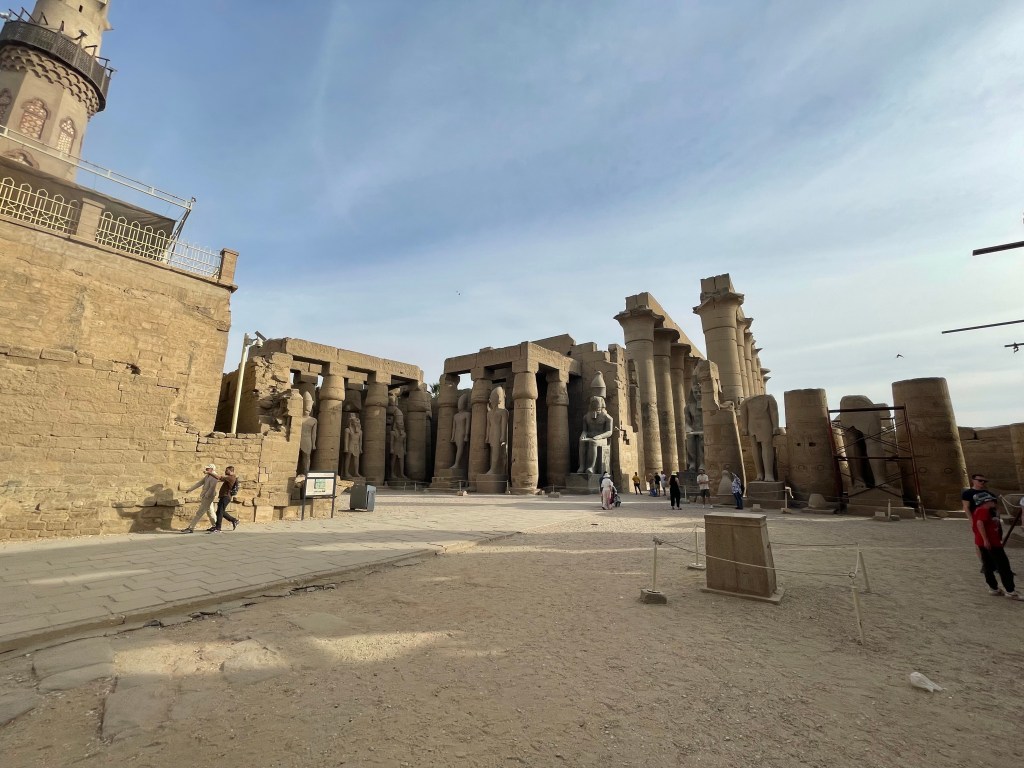


The temple complex of Ipet Resyt, The Southern Sanctuary, Luxor Temple was our final visit, it had been another long and interesting day, full of mysticism, history and intrigue. The final pictures show some of the recent artefacts found, and on display in the open air museum, and the interesting mix of cultures, the temple once housing a christian church and as you can see more recently, an active mosque.
Next stop was the airport in the morning and the flight back home. Another trip to Egypt done, and it had not let us down. The Giza plateau was immense, Saqqara and Memphis equally so, the Nile Cruise was peaceful and energetic at the same time, visits to the various temple sites were off the planet. The Valley Of The Kings had stepped things up a gear, with the electric cars making the visit so much more comfortable than previous trips.
I do hope you have found this Egyptian series of blog posts interesting. It’s very difficult trying to convey the atmosphere and feelings on these trips as Egypt is a magical place and the sites we visited, some for the 2nd or 3rd time, still conveyed a new sense of wonderment,
…………………Until Next Time………………….L8ers
